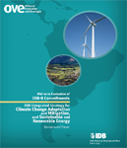IDB-9: IDB Integrated Strategy for Climate Change Adaptation and Mitigation, and Sustainable and Renewable Energy
Date
Mar 2013
This paper reviews the Inter-American Development Bank¿s Integrated Strategy for Climate Change Adaptation and Mitigation, and Sustainable and Renewable Energy (CCS). The Strategy was produced as a requirement of the IDB-9 Agreement and approved by Board of Executive Directors in March 2011. Management produced an Action Plan for the CCS in February 2012. Although the IDB-9 also mentions "food security" as a sector priority, the CCS does not include this topic, nor does it discuss "protection of the environment" more generally. In reviewing this and other sector strategies mandated in IDB-9, the Office of Evaluation and Oversight (OVE) asks two questions: Does it make sense? and Does it make a difference? The CCS is based on strong analytical work, though it does not prioritize among different agendas/instruments or highlight a key comparative advantage of the Bank: the IDB¿s ability to use technical cooperation grants to help its client countries prepare new investment operations and build needed institutional capacity. The CCS does not identify risks or provide indicators and a monitoring and evaluation framework for implementing the Strategy. IDB-9 provides a lending target of 25% by 2015 for operations for climate change, renewable energy, and sustainable environment. The number of operations has indeed increased over time. In January 2012, the Office of Strategic Planning and Development Effectiveness approved guidelines for classifying lending program priorities (GN-2650) to help ensure consistent classification and compliance with IDB-9 lending targets. These guidelines are very broad and have led to classifying about one-third of the IDB portfolio under these objectives in 2011 and 2012. It is unclear whether these numbers accurately reflect the actual size of the climate change portfolio. The Bank¿s internal staff capacity in the area of climate change has grown. The formal establishment of a Climate Change and Sustainability Division not only signals a more permanent Bank institutional commitment in and to this area, but also reportedly gives the unit greater autonomy and flexibility in terms of the operations it leads or co-leads with other divisions, including the division responsible for private sector operations. However, it is not clear if creating a new parallel sector division is the most appropriate and effective way of mainstreaming climate change considerations in the operations of other sectors. In sum, although the IDB has taken positive steps to increase its focus on climate change and environmental sustainability, the CSS is more of a conceptual document and an institutional confirmation of an evolving new area of engagement than a strategy to prioritize and guide this work.



